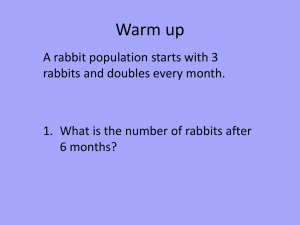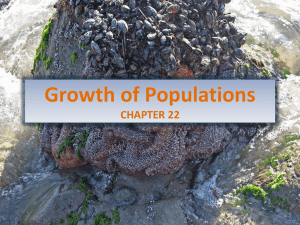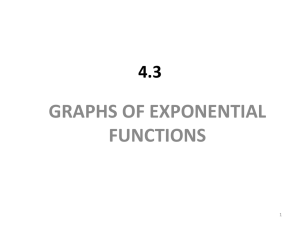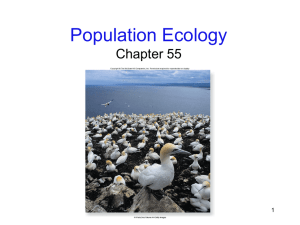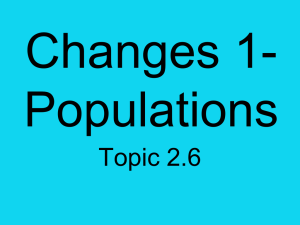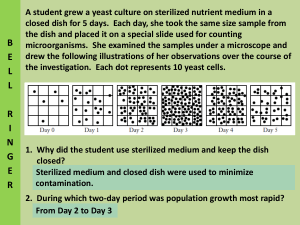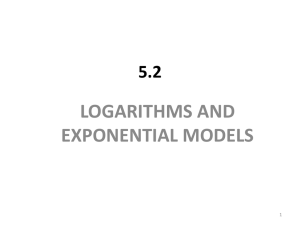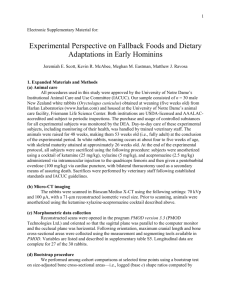Summer work answer key:
advertisement
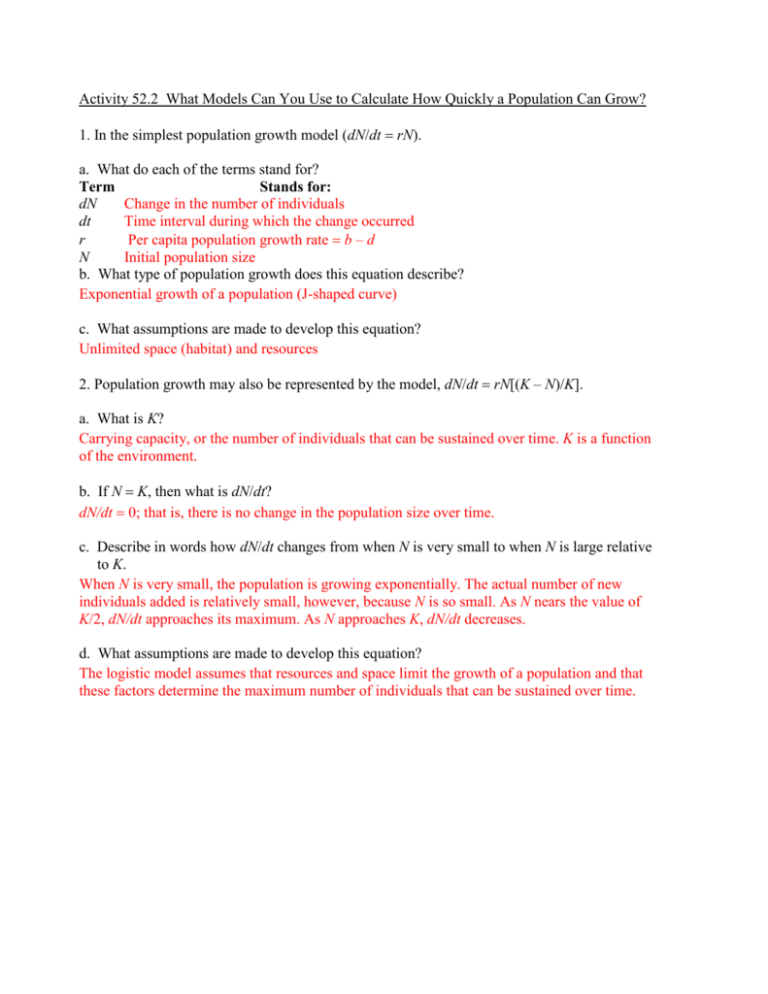
Activity 52.2 What Models Can You Use to Calculate How Quickly a Population Can Grow? 1. In the simplest population growth model (dN/dt rN). a. What do each of the terms stand for? Term Stands for: dN Change in the number of individuals dt Time interval during which the change occurred r Per capita population growth rate b – d N Initial population size b. What type of population growth does this equation describe? Exponential growth of a population (J-shaped curve) c. What assumptions are made to develop this equation? Unlimited space (habitat) and resources 2. Population growth may also be represented by the model, dN/dt rN[(K – N)/K]. a. What is K? Carrying capacity, or the number of individuals that can be sustained over time. K is a function of the environment. b. If N K, then what is dN/dt? dN/dt 0; that is, there is no change in the population size over time. c. Describe in words how dN/dt changes from when N is very small to when N is large relative to K. When N is very small, the population is growing exponentially. The actual number of new individuals added is relatively small, however, because N is so small. As N nears the value of K/2, dN/dt approaches its maximum. As N approaches K, dN/dt decreases. d. What assumptions are made to develop this equation? The logistic model assumes that resources and space limit the growth of a population and that these factors determine the maximum number of individuals that can be sustained over time. 3. You and your friends have monitored two populations of wild lupine for one entire reproductive cycle (June year 1 to June year 2). By carefully mapping, tagging, and censusing the plants throughout this period, you obtain the data listed in the chart. Parameter Population A Initial number of plants 500 Number of new seedlings established 100 Number of the initial plants that died 20 Population B 300 30 100 a. Calculate the following parameters for each population: Parameter B D b d r Population A 100 20 100/500 0.20 20/500 0.04 0.20 – 0.04 0.16 Population B 30 100 30/300 0.10 100/300 0.33 0.10 – 0.33 –0.23 b. Given the initial population size and assuming that the population is experiencing exponential growth at growth rate r, what will the number of plants be in each population in 5 years? (Use the initial population size as time zero, and compute to time 5) Population A: Population B: 1,050 81 A = (500).16 = 80new individual year 1, (580).16= 92.8 more year 2, etc. 4. You are studying the growth of a particular strain of bacteria. You begin with a tiny colony on a petri plate. One day later, you determine that the colony grew and exactly doubled in size. A calculation showed that if the colony continued to grow at the same (constant) rate, it would cover the entire plate in 30 days. a. What is value of r? See question 5. If you know r, then the doubling time is log102/log10 (1 + r) This value can be estimated by using the formula: 70 divided by the percent increase per unit time (as a whole number) equals the doubling time per unit time. Therefore, if 70/r 1 day, then r must equal approximately 0.70, or 70%. 70/100= 1day (population increased 100%, ie doubled) r b. On what day would the bacteria cover half the plate? If the bacteria colony doubles in size every day and completely covers the plate on day 30, then it must cover half the plate on day 29. 5. Using the exponential growth formula, you can determine the amount of time it will take for a population to double in size if you know r. Doubling time is equal to: log102/log10 (1 + r) Alternatively this value can be estimated by using the formula: 70 divided by the percent increase per unit time (as a whole number) doubling time per unit time. For example, in question 4 above, we can use this same formula to determine r: 70/r 1 day Therefore, r must equal about 0.70, or 70%. Using either of these formulas—the exponential growth formula or the approximate doubling rate formula—calculate the following. a. If the population of a country is growing at 2% per year, how many years will it take for the population to double? Doubling time 70/2% per year 35 years. b. If your bank account is growing at a rate of 1% per year, how many years will it take for it to double? Doubling time 70/1% per year 70 years. 6. You collect data on birth and mortality in three populations of grasshoppers, and calculate the following birth and death rates for these populations. Both populations are experiencing exponential growth: b d Population A 0.90 0.80 Population B 0.45 0.35 Population C 0.15 0.05 Are the following statements True or False? F T F T a. b. c. d. Population A is growing at the fastest rate. Population C has the lowest death rate. Population C is growing at the slowest rate. All populations are growing at the same rate. 7. In a herd of bison, the number of calves born in 1992, 1993 and 1994 was 55, 80, and 70, respectively. In which year was the birth rate greatest? You cannot answer this question unless you also know the population size for each of those years. 8. A population of pigeons on the west side of town has a per capita annual growth rate of 0.07. A separate population of pigeons on the east side of town has a per capita annual growth rate of 0.10. If the populations are both growing exponentially and both are censused the following year, in which of the populations will dN/dt be greatest? Again, you cannot answer this question because you don’t know how large the populations are initially. If the two population sizes are equal or if the population on the east side is larger than the population on the west side, then dN/dt will be greater on the east side. However, if the population on the west side is large and the population on the east side is much smaller, then dN/Dt on the west-side population could be the greater of the two. 9. Suppose you have a “farm” on which you grow, harvest and sell edible freshwater fish. The growth of the fish population is logistic. You want to manage your harvest to maintain maximum yields (that is, the maximum rate of production) from your farm over a number of years. a. Draw an idealized logistic curve showing how population size changes through time. Refer to the graph showing logistic growth in Figure 52.12 in Biology, 7th edition. b. How large should you let the population get before you harvest? Identify the point on your idealized curve and explain why. The rate of production will be fastest at the point on the curve where the slope is the steepest. dN/dt is the measure of the rate of change (that is, production) of individuals in the population. When you graph N versus t, the slope corresponds to dN/dt. When the population size (N) is very small, then [(K N)/K] is large. However, there are so few individuals in the population that the gain in population numbers, dN/dt, is also relatively small. When the population size (N) is very large, then there are many individuals but [(K – N)/K] is small. The rate of population growth (production measured as dN/dt) is at a maximum when N is equal to 1/2 K . c. Check your answer by using the following data and computing the change in population size (dN/dt) when the population is at several different levels relative to its carrying capacity. Use K 400 and rmax 0.20. Population size (N) [(K – N)/K] 50 (low) 0.875 100 (moderately low) 0.75 200 (half K) 0.5 300 (moderately high) 0.25 350 (high) 0.125 dN/dt 8.75 15 20 15 8.75 10. A rabbit population has the following life table. Age class No. of survivors No. of deaths 0–1 100 10 1–2 90 30 2–3 60 30 3–4 30 24 4–5 6 6 a. Fill in the missing data in the table. Mortality rate 0.10 .33 0.50 0.80 1.0 No. of offspring per pair 0 1.5 2.0 2.5 0 b. Owing to a good food supply and low predator population, the rabbit population is growing by leaps and bounds. The rabbits call a meeting to discuss population control measures. Two strategies are proposed: i. Delay all rabbit marriages until age class 2-3 (rabbits NEVER breed until after marriage). ii. Sterilize all rabbits in age class 3-4. Which of the proposed strategies will be more effective in slowing population growth? Explain your reasoning and show your calculations. In the first two years of their lives, each reproducing pair of rabbits will have an average of 1.5 offspring. For a cohort of 100 rabbits born in year 0–1, 90 or 45 pairs of rabbits will each have 1.5 offspring during year 1–2; they will add about 67.5 rabbits to the population. When this same cohort reaches age class 3–4, it will consist of 30 rabbits or 15 pairs, each of which will produce an average of 2.5 offspring for a total of 37.5 rabbits. Therefore, the population size will be more limited by delaying rabbit marriages until age class 2–3. 11. The chart lists the numbers of deaths per acre per year that result from the operation of two different agents of mortality (A and B) in a population of grasshoppers at different density levels. Grasshopper population size (individuals/acre) 100 1,000 10,000 100,000 Deaths per year per acre Agent A Agent B 4 0 40 25 400 500 4,000 50,000 a. Which of the two agents of mortality (A or B) is operating in a density-independent manner? Explain your answer. Regardless of the population size per acre, agent A kills only 4% of the population. In other words, it is working in a density-independent manner. Agent B is acting in a density-dependent manner because as the density changes, the percentage of individuals killed by agent B also changes. In this example, as the density of grasshoppers increases, the percentage of grasshoppers killed per acre also increases. b. Which of the two agents of mortality (A or B) is likely to act as a factor stabilizing the size of the grasshopper population? Explain your answer. No matter how large the population gets, agent A removes only 4%. In contrast, agent B removes an increasing percentage of the grasshoppers as the population size increases. Therefore, agent B is more likely to act to stabilize the size of the population over time.

